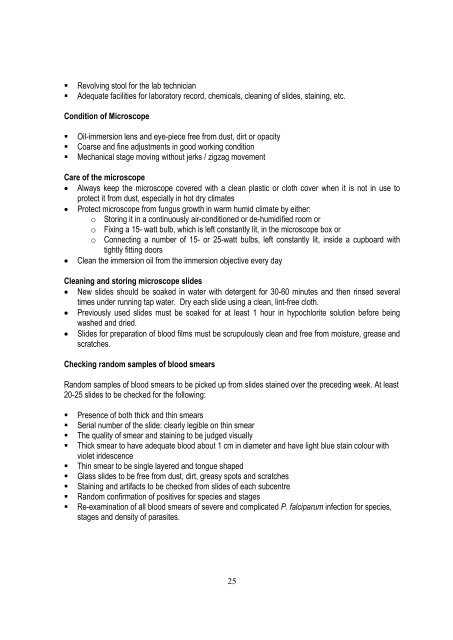training module for medical officers primary health centre - NVBDCP
training module for medical officers primary health centre - NVBDCP
training module for medical officers primary health centre - NVBDCP
- No tags were found...
Create successful ePaper yourself
Turn your PDF publications into a flip-book with our unique Google optimized e-Paper software.
Revolving stool <strong>for</strong> the lab technicianAdequate facilities <strong>for</strong> laboratory record, chemicals, cleaning of slides, staining, etc.Condition of MicroscopeOil-immersion lens and eye-piece free from dust, dirt or opacityCoarse and fine adjustments in good working conditionMechanical stage moving without jerks / zigzag movementCare of the microscope Always keep the microscope covered with a clean plastic or cloth cover when it is not in use toprotect it from dust, especially in hot dry climates Protect microscope from fungus growth in warm humid climate by either:o Storing it in a continuously air-conditioned or de-humidified room oro Fixing a 15- watt bulb, which is left constantly lit, in the microscope box oro Connecting a number of 15- or 25-watt bulbs, left constantly lit, inside a cupboard withtightly fitting doors Clean the immersion oil from the immersion objective every dayCleaning and storing microscope slides New slides should be soaked in water with detergent <strong>for</strong> 30-60 minutes and then rinsed severaltimes under running tap water. Dry each slide using a clean, lint-free cloth. Previously used slides must be soaked <strong>for</strong> at least 1 hour in hypochlorite solution be<strong>for</strong>e beingwashed and dried. Slides <strong>for</strong> preparation of blood films must be scrupulously clean and free from moisture, grease andscratches.Checking random samples of blood smearsRandom samples of blood smears to be picked up from slides stained over the preceding week. At least20-25 slides to be checked <strong>for</strong> the following:Presence of both thick and thin smearsSerial number of the slide: clearly legible on thin smearThe quality of smear and staining to be judged visuallyThick smear to have adequate blood about 1 cm in diameter and have light blue stain colour withviolet iridescenceThin smear to be single layered and tongue shapedGlass slides to be free from dust, dirt, greasy spots and scratchesStaining and artifacts to be checked from slides of each sub<strong>centre</strong>Random confirmation of positives <strong>for</strong> species and stagesRe-examination of all blood smears of severe and complicated P. falciparum infection <strong>for</strong> species,stages and density of parasites.25
















